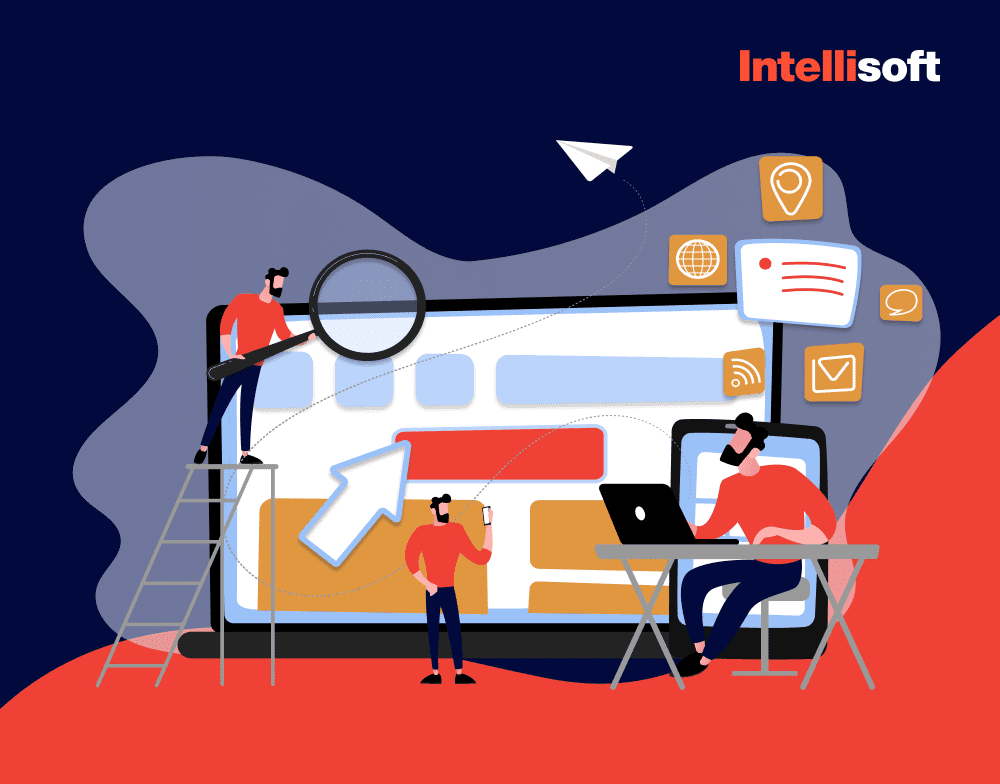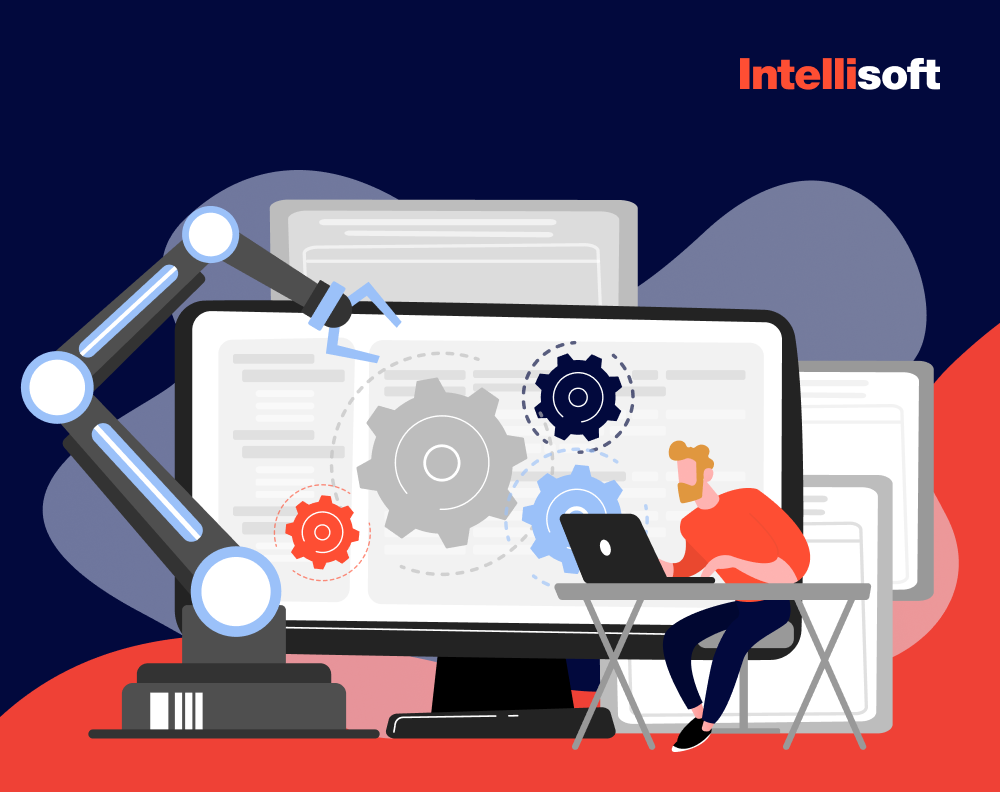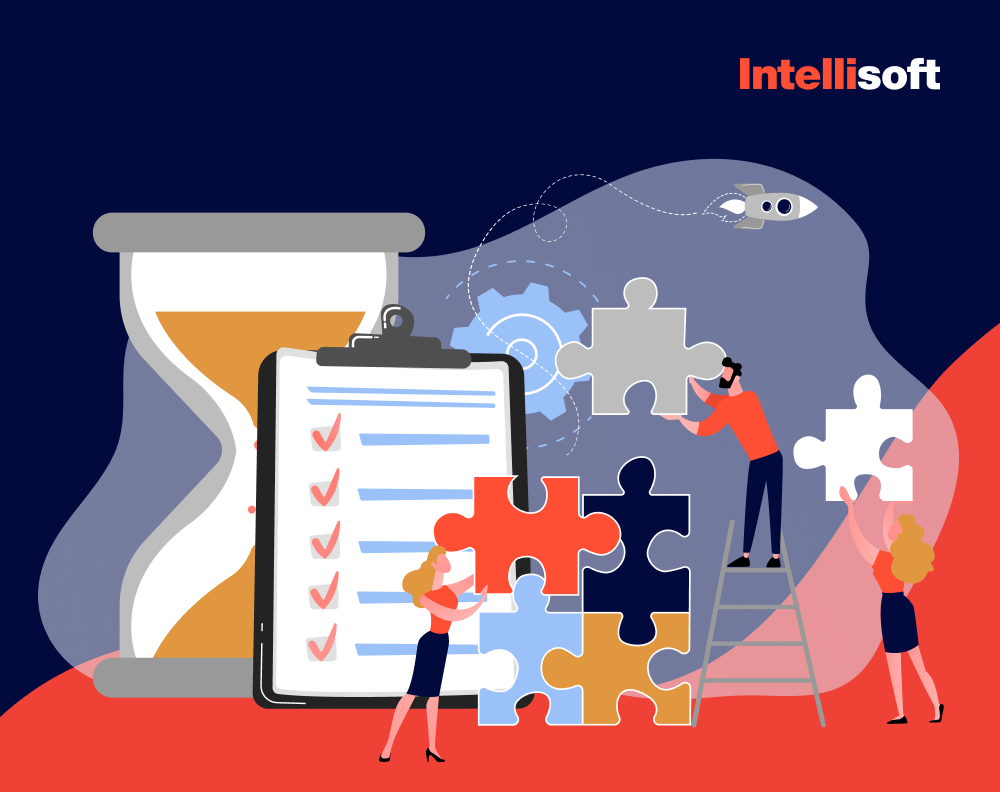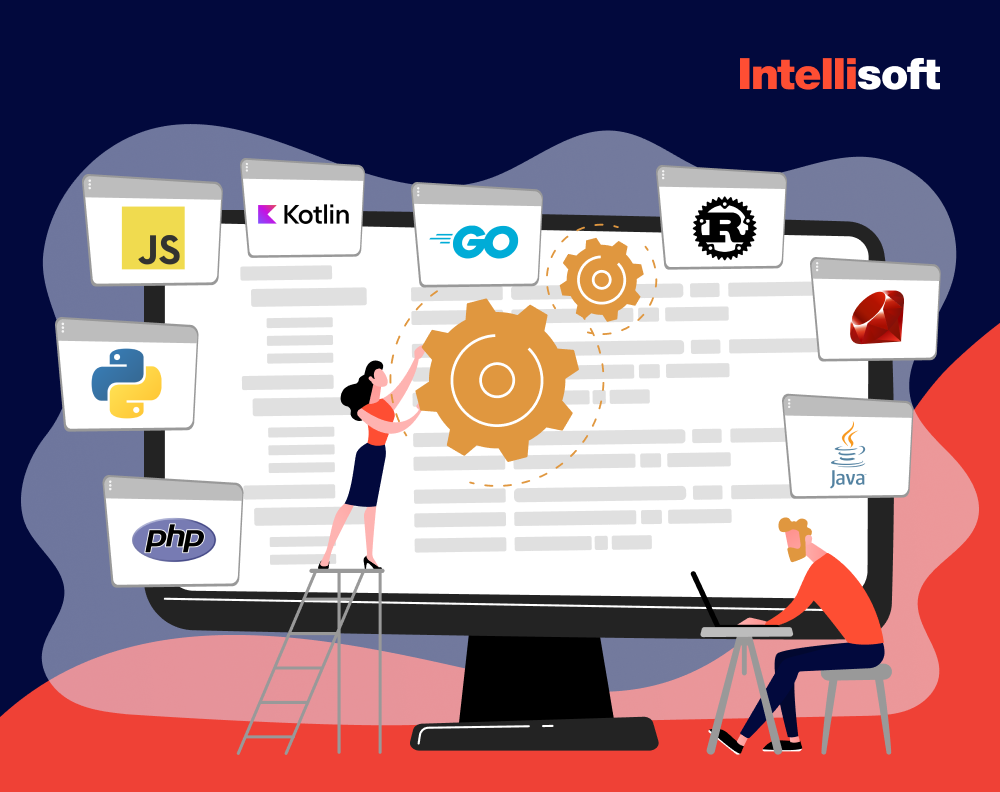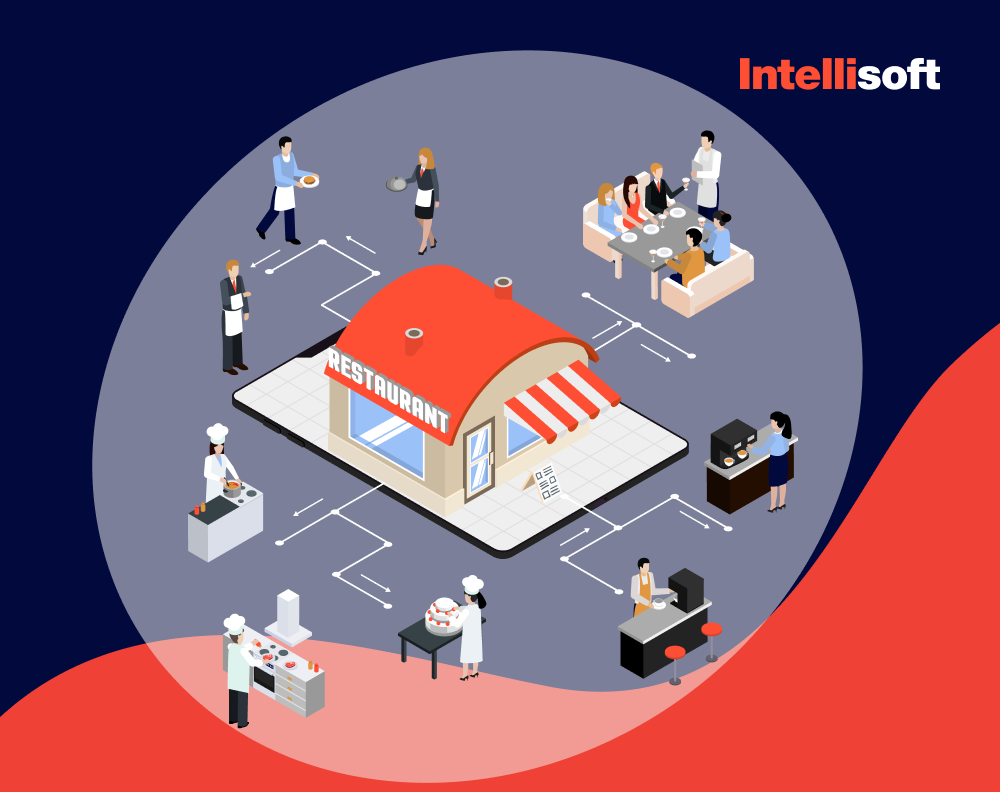Regulatory compliance is a crucial component of operational integrity and reliability in today’s corporate environment. Businesses must strike a balance between the necessity of compliance and the demands of daily operations as regulations are always changing. In this complex environment, digital solutions become invaluable friends.
Using IntelliSoft’s experience handling regulation nuances, we will address the fundamental question; “What is compliance management software?” and provide an example. Software has become a revolutionary tool for guaranteeing regulatory compliance and creating long-term success, from tracking changes to streamlining operations and reducing risks.
With over 15 years of experience in software development, IntelliSoft knows all the complexities of regulation management, and we want to share our knowledge with you. Join us as we explore the profound impact of technology on software regulatory compliance management.
Table of Contents
What is Regulatory Compliance Management Software?
This type of software is a tool that companies utilize to enhance their compliance procedures. RCM software functions as a digital hub that integrates all facets of compliance management, including monitoring regulatory changes, implementing control measures, and guaranteeing standards are followed.
Numerous businesses in different of sectors such as banking and finance, healthcare, pharmaceuticals, manufacturing, energy, and more, use compliance management system software for ensuring regulatory compliance.
For these businesses to function legally, uphold stakeholder confidence, stay out of trouble financially, and protect their brand, they must adhere to regulations.
They use it to monitor software regulatory compliance developments, assess compliance risks, develop and put into practice compliance policies and procedures, and ensure that laws are adhered to consistently.
The adoption of compliance management software is primarily propelled by the growing complexity of the regulatory environment.
Additionally, businesses may demonstrate their compliance to regulators, auditors, and other stakeholders by using regulatory compliance management software. Organizations may promote accountability by creating compliance reports, maintaining records, and putting in place strong control mechanisms.
Benefits of Using Compliance Management Software
Harnessing regulatory compliance management software effectively offers numerous benefits that can significantly enhance organizational operations:
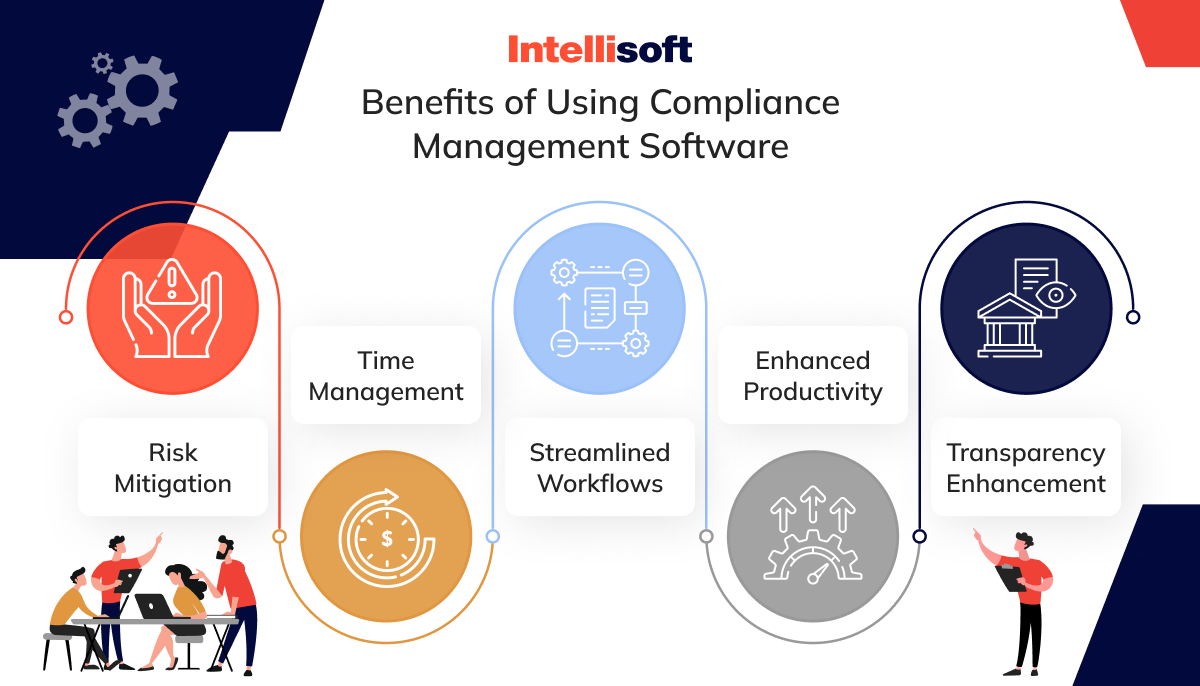
Risk Mitigation: Maximizing Compliance Confidence
Incorporating regulatory compliance management software significantly mitigates risks associated with non-compliance. By centralizing data and automating compliance processes, organizations can proactively identify potential risks, allowing for timely intervention and mitigation strategies. This proactive approach not only minimizes the likelihood of compliance breaches, but also reduces the associated penalties and reputational damage. Compliance management software empowers organizations to stay ahead of regulatory changes, ensuring they remain compliant and resilient in an ever-evolving landscape.
Time Management: Optimizing Efficiency
One of the most valuable benefits of compliance management system software is its ability to optimize time management. By automating manual tasks and providing real-time monitoring capabilities, the software streamlines processes and eliminates time-consuming administrative work.
This frees up valuable time for employees to focus on more strategic activities, such as risk analysis and compliance strategy development. As a result, organizations can achieve greater productivity and efficiency in their compliance efforts, ultimately leading to improved overall performance.
Streamlined Workflows: Harmonizing Operations
Governance risk management and compliance software harmonizes operations by standardizing and streamlining workflows across the organization. By providing a centralized platform for managing compliance-related tasks and documents, the software ensures consistency and efficiency in compliance processes.
This eliminates silos and inefficiencies, enabling seamless collaboration and communication among different departments and stakeholders. With streamlined workflows, organizations can achieve greater agility and responsiveness, adapting quickly to changing regulatory requirements and market conditions.
Enhanced Productivity: Empowering Performance
Сompliance management system software empowers organizations to enhance productivity by optimizing resource allocation and improving task prioritization. By automating repetitive tasks and providing actionable insights, the software enables employees to focus their efforts on high-value activities that drive business growth.
Additionally, real-time monitoring and reporting functionalities enable stakeholders to identify bottlenecks and inefficiencies, allowing for continuous improvement and optimization of processes. As a result, organizations can achieve higher levels of productivity and performance in their compliance efforts, leading to increased competitiveness and success in the marketplace.
Transparency Enhancement: Fostering Trust and Accountability
Transparency is critical in maintaining trust and accountability, both internally and externally. Governance risk management and compliance software enhances transparency by providing visibility into compliance activities, processes, and outcomes. Through centralized data management and robust reporting capabilities, organizations can demonstrate their commitment to compliance and integrity to regulators, customers, and other stakeholders.
This fosters trust and confidence in the organization’s operations and governance practices, enhancing its reputation and credibility in the marketplace. Additionally, increased transparency promotes accountability among employees, encouraging adherence to compliance standards and ethical behavior throughout the organization.
What Are the Features of Software Regulatory Compliance?
Governance risk management and compliance software typically includes features designed to help organizations adhere to regulations, policies, and standards. Here are some common features:
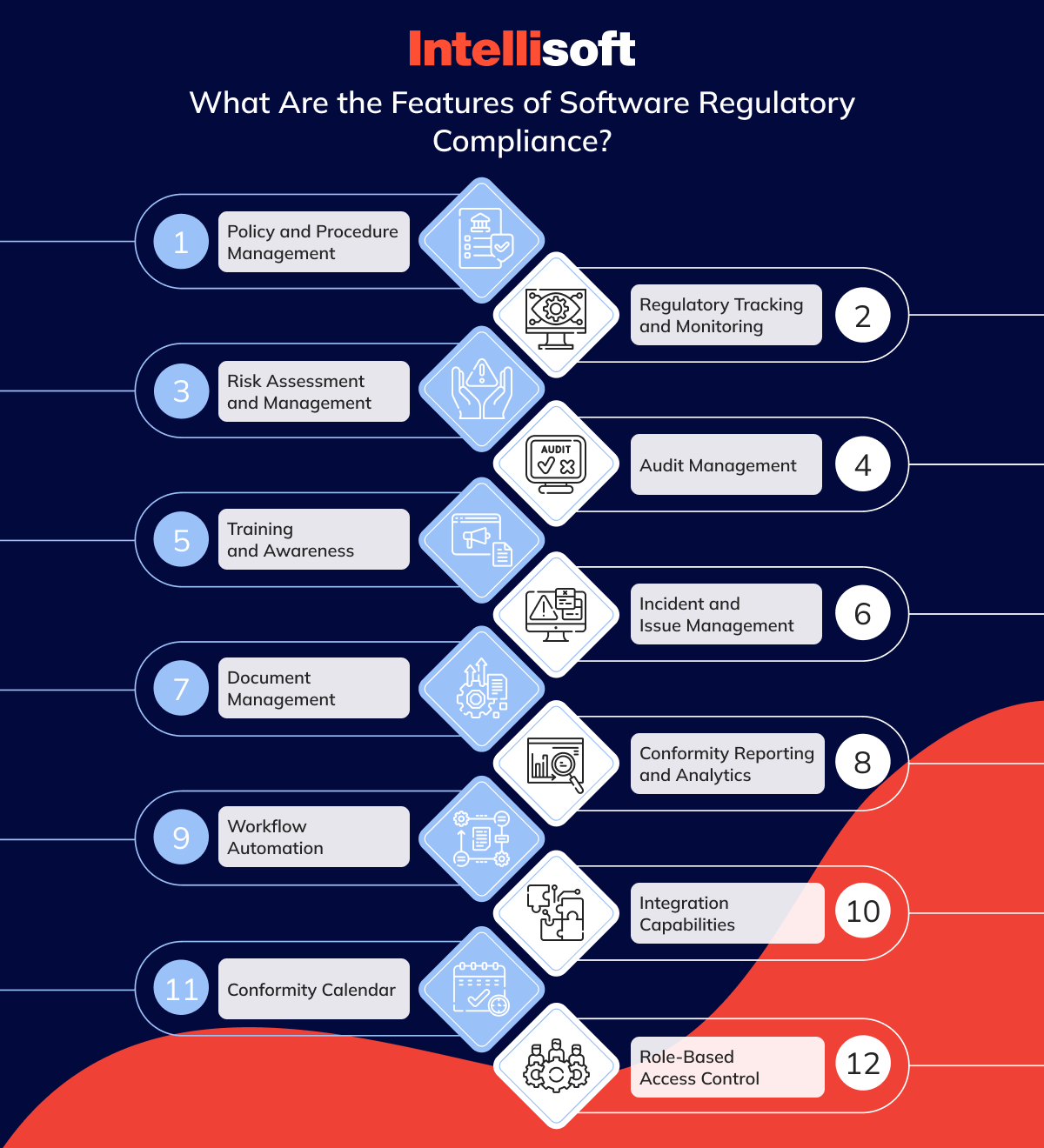
Policy and Procedure Management
This functionality within compliance management solution allows organizations to efficiently create, store, distribute, and update their policies and procedures.
This feature offers a centralized repository where all policies can be accessed by workers. It ensures that employees are aware of the organization’s rules and guidelines, helping to maintain consistency and adherence to internal standards.
Regulatory Tracking and Monitoring
Regulatory Tracking and Monitoring functionalities enable organizations to stay informed about the constantly evolving regulatory environment.
This compliance management solution capability entails monitoring multiple regulatory bodies, industry standards, and legislative revisions pertinent to the organization’s activities.
By continuously tracking regulatory updates in real-time, governance risk management and compliance software ensures that organizations can swiftly adjust their processes and policies to maintain compliance.
Risk Assessment and Management
In the realm of compliance, businesses need tools for identifying, evaluating, prioritizing, and mitigating risks associated with regulatory adherence.
Risk assessments are carried out as part of this procedure to evaluate the possibility and possible consequences of compliance violations. Organizations learn more about the particular risks they face and the possible outcomes by using these evaluations. As such, they are able to create customized plans of action and strategies to deal with threats that have been identified.
Audit Management
This compliance management solution functionality streamlines the planning, execution, and tracking of compliance audits. It enables organizations to schedule audits, assign tasks to auditors, conduct audit fieldwork, and track audit findings and remediation activities.
Compliance management software may provide customizable audit templates, checklists, and workflows to standardize the audit process and ensure consistency across audits.
Moreover, it may include features for documenting audit evidence, generating audit reports, and tracking audit findings to closure, complying with internal policies and external regulations.
Training and Awareness
This functionality helps organizations educate employees about conformity requirements and promote a culture of complying.
This functionality typically includes tools for developing and delivering conformity training programs, as well as tracking employee participation and completion.
It may also provide features for tracking training progress, scheduling recurring training sessions, and generating training compliance reports to demonstrate regulatory compliance.
Incident and Issue Management
Organizations may efficiently respond to and address conformity-related problems by utilizing incident and issue management features, which guarantees prompt resolution and prevents recurrence.
This feature offers an organized system for recording, reporting, and looking into events such as policy infractions, breaches, or moral dilemmas.
Through the assignment of investigative duties, tracking of remedial actions, and the facilitation of incident reporting, embedded compliance management software optimizes the incident management process.
By keeping an audit record of all incident-related activities and conversations, it also guarantees accountability and transparency.
Document Management
This feature helps centralize the storage, organization, and retrieval of conformity-related documents, such as policies, procedures, regulations, and audit reports.
This feature provides a secure repository where documents can be stored, version-controlled, and accessed by authorized users.
Embedded compliance management software may offer document categorization, tagging, and search capabilities to facilitate document retrieval.
Conformity Reporting and Analytics
Conformity Reporting and Analytics features enable organizations to generate reports and analyze conformity data to monitor performance, identify trends, and measure effectiveness.
This functionality provides dashboards, customizable reports, and data visualization tools for presenting compliance metrics and key performance indicators (KPIs).
Compliance management solutions may offer pre-built report templates for common conformity requirements, as well as ad-hoc reporting capabilities for generating custom reports.
Moreover, it may include analytics features for conducting trend analysis, root cause analysis, and predictive modeling to enhance conformity decision-making.
Workflow Automation
Workflow Automation functionality automates repetitive conformity-related tasks and processes, reducing manual effort and improving efficiency.
This feature enables organizations to design and implement automated workflows for various conformity activities, such as policy review, approval processes, and audit scheduling.
Compliance management solutions provide drag-and-drop workflow builders, configurable templates, and rules-based automation capabilities to streamline compliance workflows.
Moreover, it integrates with other systems and tools, allowing seamless data exchange and interoperability across the organization.
By automating routine tasks, organizations can free up valuable time and resources, minimize errors, and ensure consistent adherence to compliance requirements.
Integration Capabilities
Easy data exchange and interoperability are made possible by integration capabilities, which also promote a smooth interaction between compliance management systems and other apps or systems in the company’s IT ecosystem.
The data transmission between compliance management solutions and other corporate systems, such as document management, HR, and ERP systems, is made easier by this feature. The compliance management software offers pre-packaged connections, connectors, and APIs that make integration easier and guarantee a consistent data flow between systems.
Conformity Calendar
The Compliance Calendar feature provides organizations with a visual representation of compliance-related deadlines, milestones, and events, ensuring timely action and adherence to regulatory technology requirements.
This feature offers a centralized calendar interface where users can view upcoming compliance tasks, deadlines, and scheduled events.
Compliance management solutions provide customizable calendar views, color-coded entries, and reminders to help users stay organized and prioritize their conformity activities effectively.
What’s more, it supports recurring task scheduling, automated reminders, and notifications to ensure that critical compliance obligations are not overlooked.
By utilizing the Compliance Calendar feature, organizations can proactively manage their conformity obligations and minimize the risk of non-compliance.
Role-Based Access Control
Role-Based Access Control (RBAC) is a core feature in conformity management software that regulates access to sensitive compliance information based on users’ roles.
It allows businesses to define roles with specific permissions and ensure that users have access to the data necessary for their job responsibilities.
RBAC helps enforce security measures by minimizing the risk of unauthorized access and provides an audit trail for tracking user activities, aiding in compliance with regulatory technology requirements.
Overall, RBAC is essential for enhancing security, ensuring regulatory compliance, and maintaining data integrity within conformity management systems.
Related readings:
- What Is a Secure Software Development Life Cycle?
- Why Does Your Tech Start-up Need a Business Plan and How to Create One?
- What Is Cross-Platform App And Why to Choose It?
- How to Build an iOS App for Your Start-up
- Steps to Develop a Successful Mobile App for Android
What are Real Examples of Leveraging Compliance Management Software?
From financial institutions to healthcare providers, manufacturing companies to pharmaceutical giants, and technology firms, software regulatory compliance has become a strategic imperative.
Let’s explore how to ensure regulatory compliance and how these diverse sectors utilize such software to ensure adherence to regulations and standards while enhancing operational efficiency and mitigating compliance risks.
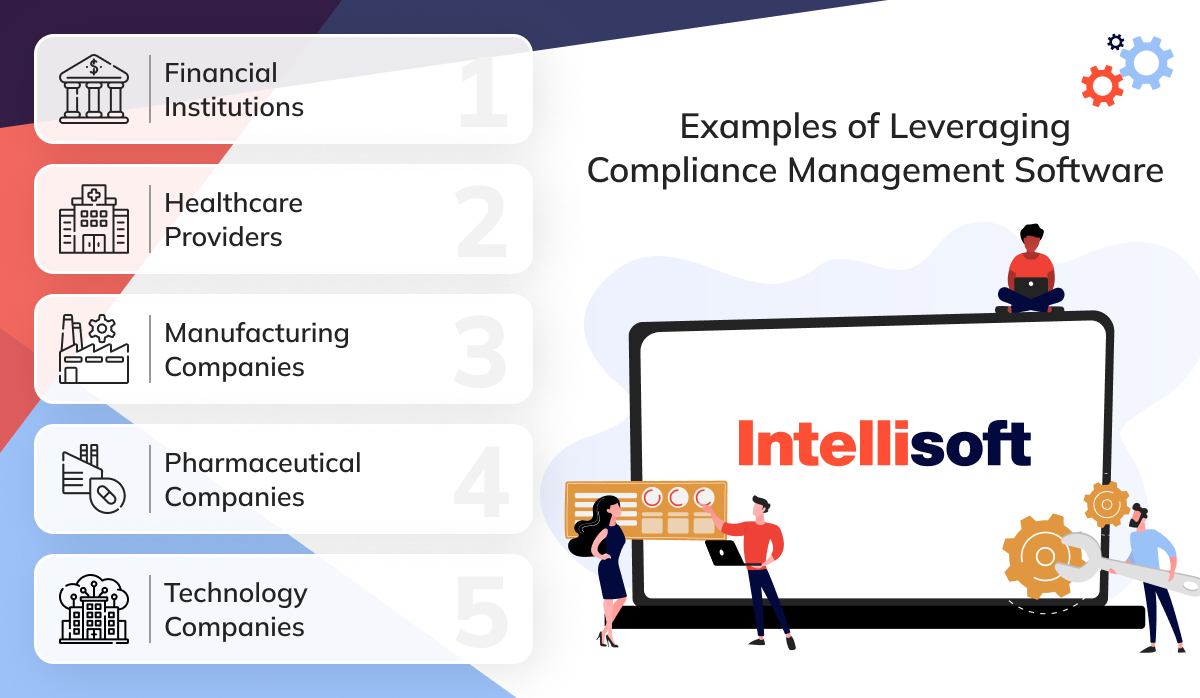
Financial Institutions
Financial institutions use conformity management software to ensure adherence to regulatory requirements such as anti-money laundering (AML) regulations, Know Your Customer (KYC) policies, and data security standards like PCI DSS. This software regulatory compliance helps automate conformity processes, manage regulatory changes, conduct risk assessments, and streamline audit procedures.
Healthcare Providers
Healthcare providers rely on conformity management software to uphold compliance with healthcare regulations such as HIPAA (Health Insurance Portability and Accountability Act) and GDPR (General Data Protection Regulation). This software aids in securely managing patient data, enforcing privacy policies, ensuring staff training on compliance requirements, and facilitating incident reporting and response.
Hospitals and clinics leverage conformity management software to perform routine risk assessments, monitor regulatory updates, and streamline conformity audits. This ensures the protection of patient information and adherence to regulatory technology standards.
Manufacturing Companies
Manufacturing companies employ conformity management software to comply with industry-specific regulations such as ISO standards, OSHA (Occupational Safety and Health Administration) requirements, and environmental regulations. This software helps manage product quality and safety standards, track regulatory changes impacting manufacturing processes, ensure employee safety training, and streamline conformity documentation and reporting.
Manufacturing firms utilize conformity management software to implement corrective actions, monitor supply chain conformity, and maintain certifications necessary for operating in regulated markets.
Pharmaceutical Companies
Pharmaceutical companies rely on conformity management software to meet stringent regulations governing drug manufacturing, distribution, and marketing, such as FDA (Food and Drug Administration) regulations and Good Manufacturing Practices (GMP). This software assists in managing clinical trial conformity, tracking adverse events, ensuring product labeling conformity, and maintaining documentation for regulatory submissions.
Pharmaceutical firms use conformity management software to streamline conformity audits, track changes in regulatory requirements, and manage quality control processes to ensure product safety and efficacy.
Technology Companies
Technology companies leverage regulatory technology to navigate complex regulatory landscapes and ensure conformity with data protection regulations like GDPR, CCPA (California Consumer Privacy Act), and SOC 2 (Service Organization Control 2) standards. This software helps manage data privacy policies, conduct data protection impact assessments, track user consent, and respond to data subject access requests.
Technology firms use conformity management software to implement security controls, monitor cybersecurity threats, and demonstrate conformity to customers and regulatory authorities.
What Are the Different Types of Regulatory Management Tools?
In today’s regulatory landscape, organizations require robust tools to effectively manage their conformity obligations. Several types of management tools cater to different aspects of regulatory conformity across various industries. Understanding these tools is essential for organizations seeking to streamline their processes and mitigate risks effectively. Here are some of the key types of conformity management tools:
- Policy and Procedure Management Software. These tools help organizations create, disseminate, and track conformity policies and procedures, ensuring alignment with regulatory requirements and internal standards.
- Risk Management Software. Risk management tools assist organizations in identifying, assessing, and mitigating conformity risks by providing frameworks for risk analysis, risk registers, and risk treatment plans.
- Audit Management Software. These tools streamline the audit process, from planning and scheduling audits to conducting fieldwork, documenting findings, and tracking remediation activities.
- Training and Awareness Platforms. Training software helps organizations deliver conformity training programs to employees, track completion, and ensure staff awareness of regulatory requirements and best practices.
- Incident and Issue Management Systems. Incident management tools enable organizations to report, investigate, and resolve conformity-related incidents promptly, ensuring transparency and accountability.
- Document Management Solutions. Document management software centralizes the storage, organization, and retrieval of conformity-related documents, facilitating document control, versioning, and access control.
- Conformity Reporting and Analytics Tools. These tools generate reports and analytics on conformity performance, enabling organizations to monitor trends, identify areas for improvement, and demonstrate conformity to stakeholders.
- Workflow Automation Software. Workflow automation tools automate repetitive conformity tasks, streamline processes, and reduce the risk of errors, improving efficiency and conformity consistency.
- Integration Platforms. Integration solutions facilitate seamless data exchange between conformity management software and other systems or applications within the organization’s IT ecosystem, ensuring data consistency and interoperability.
- Conformity Calendar Software. These calendar tools provide a centralized view of conformity-related deadlines, milestones, and events, helping organizations stay organized and proactive in managing their compliance obligations.
Understanding the different types of compliance management tools allows organizations to select the right solutions tailored to their specific compliance needs, industry regulations, and organizational requirements. By leveraging these tools effectively, organizations can enhance their compliance posture, minimize risks, and achieve operational excellence.
Top 5 Best Regulatory Management Tools of 2024
In the ever-evolving landscape of regulatory management, staying ahead requires the right tools. Here are the top 5 compliance management tools leading the way in 2024:
Sprinto
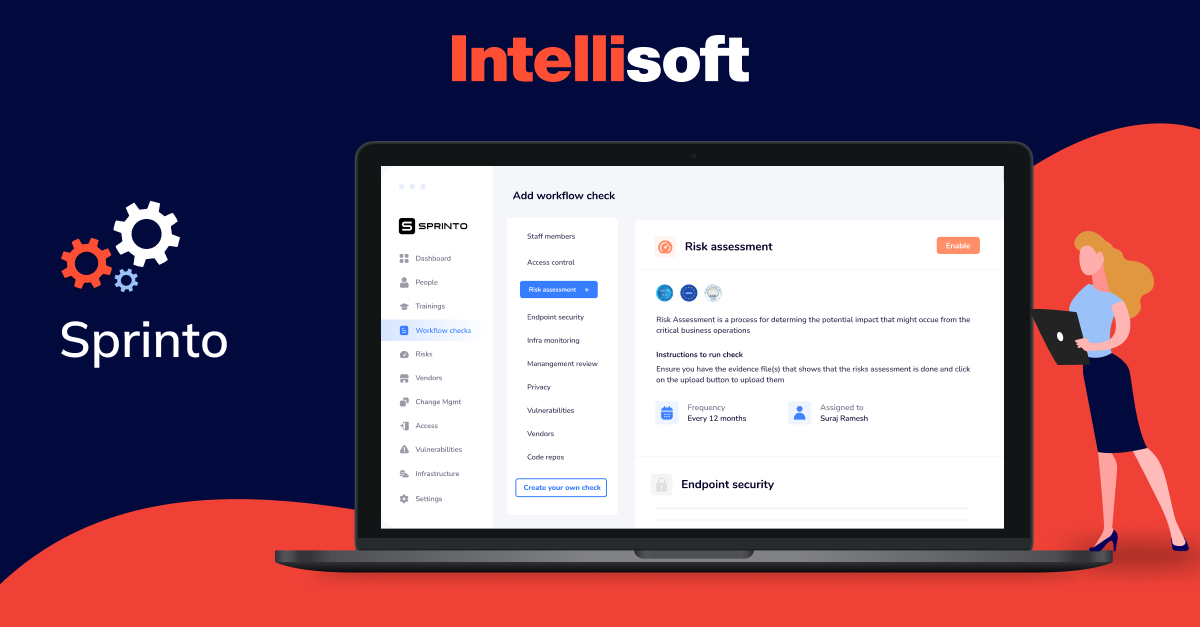
Sprinto is a security compliance provider that offers compliance automation capabilities for cloud companies.
Features:
- Policy and Procedure Management. Sprinto provides a centralized repository for creating, storing, and managing policies and procedures. It offers version control, approval workflows, and document tracking features.
- Risk Assessment. Sprinto facilitates risk identification, assessment, and mitigation through customizable risk matrices, risk registers, and risk scoring methodologies.
- Audit Management. The platform streamlines audit planning, execution, and reporting processes. It offers audit scheduling, task assignment, evidence collection, and audit findings tracking capabilities.
- Incident Reporting. Sprinto enables users to report, investigate, and resolve compliance incidents efficiently. It provides incident intake forms, escalation workflows, and root cause analysis tools.
- Integration Options. Sprinto offers seamless integration with other systems and tools, such as ERP systems, HR platforms, and document management systems, ensuring data consistency and interoperability.
Supported Frameworks. Sprinto supports various compliance frameworks and standards, including ISO 9001 (Quality Management), ISO 27001 (Information Security Management), and COSO (Committee of Sponsoring Organizations of the Treadway Commission) for internal controls.
Complinity

Complinity is a streamlined compliance management platform, helping businesses navigate regulations effortlessly and mitigate risks efficiently. It centralizes compliance processes, automates workflows, and offers real-time monitoring to ensure adherence to industry standards and regulations.
Features:
- Policy Management. Complinity allows organizations to create, distribute, and track compliance policies and procedures. It offers automated policy acknowledgment, version control, and policy training features.
- Training and Awareness. The platform provides tools for delivering and tracking compliance training programs. It offers online training modules, quizzes, and certifications to ensure employee awareness and competency.
- Incident Tracking. Complinity facilitates incident reporting and management processes. It allows users to log incidents, assign tasks for investigation, and track resolution progress.
- Compliance Reporting. Complinity generates customizable reports and dashboards to monitor compliance performance. It offers real-time analytics and trend analysis features to identify compliance gaps and opportunities for improvement.
- Automation Capabilities. Complinity automates repetitive compliance tasks, such as policy review cycles, training reminders, and audit scheduling, improving efficiency and reducing manual effort.
Supported Frameworks. Complinity supports a wide range of regulatory frameworks and standards, including HIPAA (Health Insurance Portability and Accountability Act), GDPR (General Data Protection Regulation), and SOX (Sarbanes-Oxley Act) for financial reporting compliance.
Arena QMS
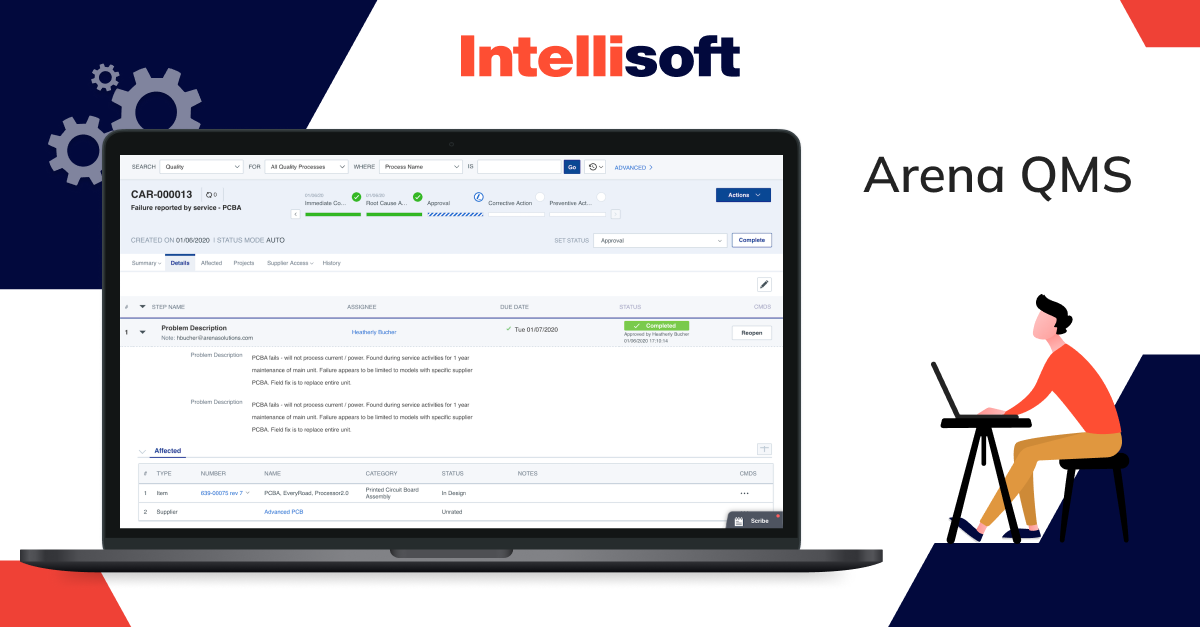
Arena QMS is a comprehensive quality management system designed to streamline processes and ensure compliance with industry standards.
Features:
- Document Control. Arena QMS centralizes document management processes, ensuring version control, document approval workflows, and document access control.
- Change Management. The platform facilitates change control processes for managing product changes, revisions, and approvals. It offers change request forms, impact assessments, and change notification features.
- Audit Trails. Arena QMS maintains audit trails for tracking changes to documents, processes, and quality records. It provides visibility into user actions and system activities for compliance and accountability purposes.
- Supplier Management. The platform includes supplier quality management features for evaluating supplier performance, conducting supplier audits, and managing supplier documentation.
- Collaboration Tools. Arena QMS offers collaboration tools for cross-functional teams to collaborate on quality and compliance initiatives. It supports document sharing, commenting, and approval workflows to streamline collaboration.
Supported Frameworks. Arena QMS supports quality management frameworks such as ISO 9001 (Quality Management Systems), ISO 13485 (Medical Devices), and FDA 21 CFR Part 820 (Quality System Regulation) for medical device manufacturers.
Microsoft 365 E5 Compliance
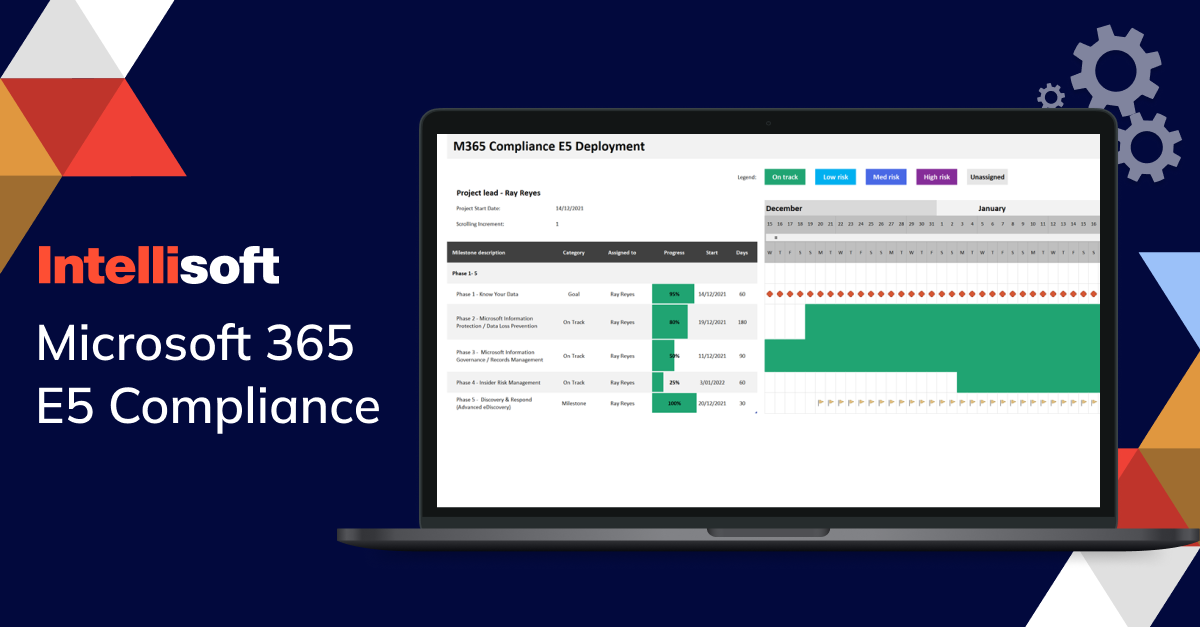
Microsoft 365 E5 Compliance is a comprehensive suite of tools and features aimed at helping businesses manage compliance and mitigate risks effectively. It includes advanced capabilities for data governance, eDiscovery, and insider risk management, providing organizations with the necessary resources to protect sensitive information and adhere to regulatory requirements.
Features:
- Data Loss Prevention (DLP). Microsoft 365 E5 Compliance helps organizations prevent data loss by identifying and protecting sensitive information across Microsoft 365 applications, such as Exchange, SharePoint, and OneDrive.
- eDiscovery. The platform offers eDiscovery capabilities for identifying, preserving, and collecting electronic evidence for legal matters and regulatory investigations.
- Insider Risk Management. Microsoft 365 E5 Compliance helps organizations detect and mitigate insider risks, such as data leaks, unauthorized access, and malicious activities by insiders.
- Information Governance. The platform provides tools for managing information lifecycle, retention policies, and data governance across Microsoft 365 environments.
- Advanced Threat Protection. Microsoft 365 E5 Compliance includes advanced threat protection features to safeguard against sophisticated cyber threats, such as phishing, malware, and ransomware attacks.
Supported Frameworks. Microsoft 365 E5 Compliance aligns with various regulatory frameworks and standards, including GDPR (General Data Protection Regulation), HIPAA (Health Insurance Portability and Accountability Act), and CCPA (California Consumer Privacy Act) for data privacy and protection compliance.
iComplyKYC
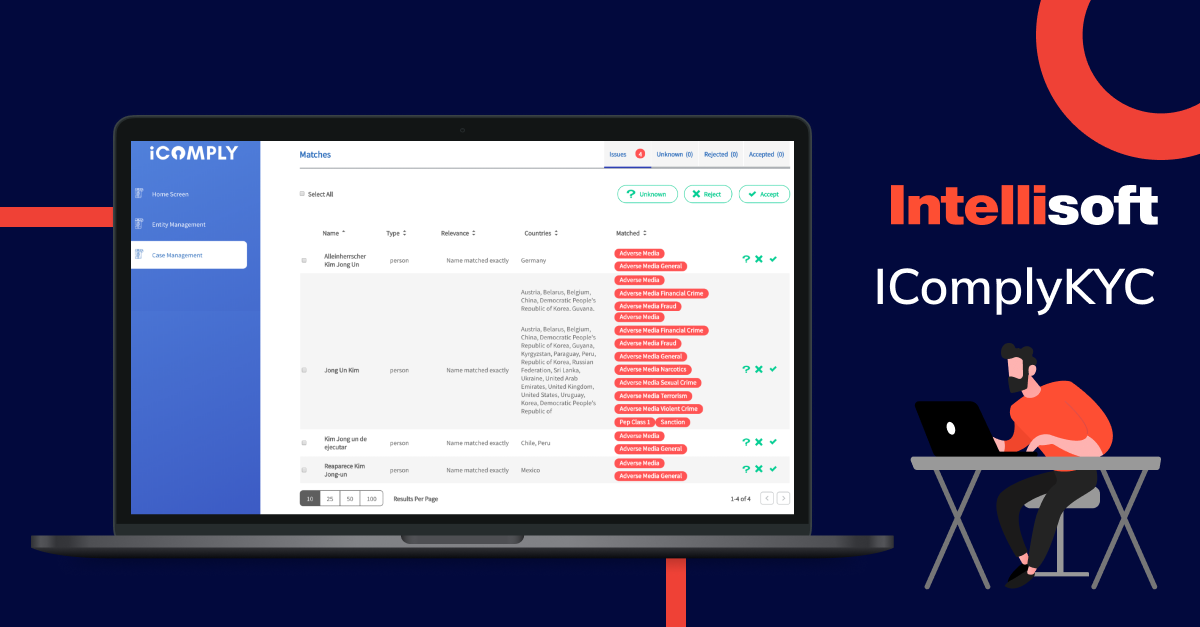
iComplyKYC is a leading compliance automation platform specializing in Know Your Customer (KYC) processes. It offers advanced solutions for customer due diligence, identity verification, and regulatory compliance in the financial industry.
Features:
- Identity Verification. iComplyKYC offers automated identity verification solutions, including document verification, biometric authentication, and liveness detection, to ensure the identity of customers and counterparties.
- Risk Assessment. The platform conducts risk assessments on customers and transactions to detect potential money laundering activities, terrorist financing, and other financial crimes.
- Transaction Monitoring.iComplyKYC provides transaction monitoring capabilities to track suspicious activities, identify anomalies, and generate alerts for further investigation.
- Regulatory Reporting. The platform assists organizations in generating regulatory reports and filings required by financial regulators, such as SARs (Suspicious Activity Reports) and CTRs (Currency Transaction Reports).
- Audit Trails. iComplyKYC maintains audit trails of all user activities and system interactions for compliance and audit purposes, ensuring transparency and accountability.
Supported Frameworks. iComplyKYC aligns with global regulatory frameworks and guidelines, including FATF (Financial Action Task Force) recommendations, AMLD (Anti-Money Laundering Directive), and OFAC (Office of Foreign Assets Control) sanctions lists for anti-money laundering compliance.
Integrating Compliance Management Software with IntelliSoft
At IntelliSoft, we understand the paramount importance of seamless integration with regulatory management software to elevate organizational efficiency and ensure unwavering regulatory compliance. With our wealth of experience and unparalleled expertise, we stand as your trusted partner in navigating the intricate landscape of regulatory management.
Why Choose Us as Your Outsource Partner?
- Extensive Industry Experience. With over 15 years of experience in software development, we have honed our expertise in delivering innovative solutions that meet the evolving needs of our clients across diverse industries.
- Commitment to Quality. Quality is at the core of everything we do. As your outsource partner, we are committed to delivering solutions that not only meet but exceed your expectations, ensuring the highest levels of performance, reliability, and security.
- Strategic Partnership Approach. We believe in building long-term partnerships with our clients based on trust, collaboration, and mutual success. As your outsource partner, we are dedicated to understanding your unique business requirements and delivering tailored solutions that drive tangible results.
- Cost-effective Solutions. Outsourcing software development to IntelliSoft allows you to leverage our expertise and resources without the overhead costs associated with maintaining an in-house development team. Our cost-effective solutions help you maximize your ROI while minimizing your operational expenses.
- Proven Track Record. Our track record speaks for itself. Over the years, we have successfully delivered numerous projects on time and within budget, earning the trust and satisfaction of our clients.
Contact us today to learn more about how our integrated solutions can elevate your compliance management efforts and drive sustainable business growth. Together, let’s navigate the complexities of compliance with confidence and ease.





